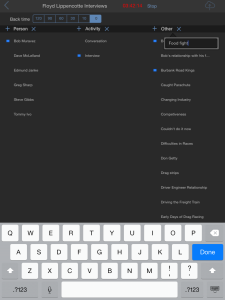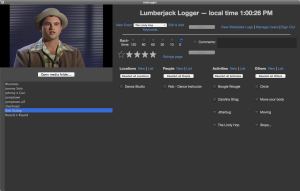I frequently find myself evolving my position on technology as new information comes to light. As my email sig line used to say “Above all, I reserve the right to be wrong”. As new information comes to light, or reaching a certain point in thinking allows another perspective to open up, my positions frequently evolve.
One example would be the use of 4K, another is the development of Lumberjack System.
When the push to 4K started I dismissed it (quite accurately) as merely being driven by a need to sell more display panels, cameras and other gear. I thought it was another “3D” – a technology pushed on people that wasn’t needed. I still believe that 4K in the home – like 3D in the home before it – is a non starter.
In production, 4K has a lot of advantages, and as I found myself saying things like “I wish I had more resolution so I could push in here, and then here to make two shots out of this overhead” and “the reason to shoot GoPro image sequences over video is the ability to push in on part of the frame.” As these words left my mouth I realized how I was making the case for 4K acquisition!
I still have reservations on how this approach will be abused by trying to shoot only one 4K – or 8K – angle and trying to cut from that. But make it two cameras and two angles, and the idea isn’t so horrible any more. As my friend Terry Current says in an upcoming Terence and Philip show:
“the most expensive part of making something is the production and shooting two (or 3) 4K angles will allow for fewer takes (and less variability in the performance) and faster production, so it is inevitable.”
And there’s Lumberjack! Long time readers will remember that has become Lumberjack System was initially conceived in 2012 to solve a problem I had producing a reality series on a small, solar powered boat, editing as we went with Final Cut Pro X. It became obvious that logging as we shot was the only viable solution to that problem.
Research showed that there were no suitable solutions for non-scripted material available. So we made one.
Lumberjack had a long gestation: from that aborted production in 2012, through extensive beta testing (internal and external) in 2012, 2013 and in to 2014. As we used Lumberjack in practical situations, the more I realized how valuable it was.
String-outs
We added the ability to do basic string-outs very early in the development. A string-out takes all the keyword ranges logged in Lumberjack System for a person, activity or other keyword, and strings them out in a simple, time sequential string-out of matching clips into a Compound Clip. They are intended as a pre-edit tool to quickly find and manipulate specific content.
As I used the string-outs I realized we had a basic design flaw. It was easy to add string-outs in the Lumberyard app while adding keywords, but if the project spanned more than a couple of days, there was no way to string-out selects from all the Events (all the shot material). This led to the development of our new Story mode.
We had to wait for a unified Library XML format (introduced in FCPX 10.1.2) before we could send multiple logged Events back from Final Cut Pro X to Lumberyard and have Lumberyard use the Keyword Ranges from the logged FCP X Events, not the online database, for string-outs.
Log Offline with Lumberjack?
We also previewed it to people, and got good feedback. The most obvious need was to be able to log “offline”: without the Internet. We experienced the need ourselves, more than once. During that drawn-out beta we got a lot of valuable feedback from our internal and external testers and Lumberjack evolved. On Solar Odyssey we had “guaranteed” internet access for logging off-boat by having triple redundancy. On boat we were only logging to a local server. We found that this requirement was a problem for some people and was going to limit the usability.
Obviously we needed to solve that problem, leading to the development of an iOS Offline Logger, released Monday July 7th and is available in the App Store free as part of your Lumberjack System subscription.

Log already shot footage with Lumberjack?
Another common question was if Lumberjack System could log already shot footage. I was adamant, however, that Lumberjack was a real-time logging tool. It had to be, as it uses UTC (time-of-day with time zone) as its method of synchronizing between logs and media.
I passed through several phases in my thinking. Even though we had a couple of requests, it most certainly wasn’t practical to log footage already shot as there was no easy way to synchronize the times. Lumberjack System was for new projects shooting now. If it wasn’t logged real-time during the shoot, then FCP X was the next-best logging tool.
Then a funny thing happened. I had a project that was not logged during the shoot with Lumberjack System, so it needed to be logged in Final Cut Pro X. This was the first time in over two years I’d logged something in FCP X, not in Lumberjack. Well, yes, Final Cut Pro X is definitely a great logging tool. Except…
Except, it was a lot more complicated than Lumberjack and in most cases took longer and required a lot more keystrokes. My thinking shifted to thinking we could add value with a real-time logger for already shot footage as part of Lumberjack System. What a pity I thought that was impossible!
From there I went though a couple of iterations of ideas: what the interface should be like; and then the realization that we probably couldn’t play most of the formats supported by FCP X. Then testing and discovering that most media formats ingested into FCP X will work with AV Foundation’s AVPlayer, so we were in business.
I had one idea for solving the synchronizing challenge: Greg came up with a better one.
So now we have a beta app for logging already shot footage that integrates into Lumberjack System.

In each case our experience of using Lumberjack, and getting feedback, has led to an evolution in my thinking, much as my thinking on 4K evolved. I trust I will continue to evolve as new ideas and new challenges present themselves.